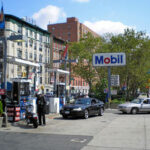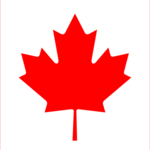Everyone on both sides of the US-Canadian border, if they live this close, has done some cross-border shopping.
Canadians came to the States for products not sold in Canada, and to shop on Sunday. Americans went to Canada to take advantage of the exchange rate. A US dollar was always worth around 1.40 Canadian.
When I lived in Detroit in 1979, gas hit — OMG — 70 cents a gallon, and it was cheaper to fill the tank in Windsor. The posted prices were higher, but Canada had not yet gone metric and sold gas in British Imperial gallons that were about one-fifth larger than US gallons. With the favorable exchange rate and after measurement conversion, even with the bridge and / or tunnel tolls both ways figured in, you’d still save a few bucks on a fill-up. I made more than one cross-border trip for that reason only. Do some shopping, have dinner, and the savings would increase. The more you spend, the more you save, as long as your purchases don’t exceed the duty-free limit for visits of less than 48 hours.
As late as 2004, at the currency exchange on the Canadian side of the Blue Water Bridge in Sarnia, I would get 1.50 Canadian for a US dollar.
Monsieur Tom, besides reading the French on cereal boxes and bags of cat food (“nourriture pour chats”), got a kick from paying for a dollar item with a US one dollar bill and getting change back. Everyone, from the big stores to the small corner “variety” stores, accepted American money. A favorite fish and chips restaurant not only took Yankee greenbacks, but gave change in US funds.
Back in the USA, where even Canadian pennies were sometimes refused: the Port Huron branch of a certain national department store chain totaled the amounts of Canadian money found in cashiers’ tills at the end of their shifts and deducted it from their pay.
Canadians, even though stores in the States discounted their dollar as much as twenty percent, still came here to shop. Lower prices, and bypassing the Canadian national Goods and Services Tax (GST) offset the bridge tolls both ways. In the parking lots, on a Saturday afternoon, about one in four cars had Ontario license plates. Some came in RVs and spent the night free in parking lots where they were allowed to do so, to earn duty-free exemptions for a stay of more than 24 hours.
The United States went off the gold standard in 1933. Bank notes could no longer be exchanged for gold coins, and gold coins were no longer legal tender. The last silver coins were minted in 1964. Silver certificates — paper money whose text stated the bearer could exchange it for silver coins — still circulated. Those notes became obsolete in 1970. US currency became completely “fiat” — not backed by anything, worth its face value only because the government said it was worth that much.
In 1971, the Nixon administration came up with a workaround. The US cut a deal with Saudi Arabia, the largest producer of oil and the most influential country in OPEC, the Organization of Petroleum Exporting Countries. In return for assuming responsibility for Saudi Arabia’s military defense (from who? Our good friend Israel?), the Saudis assured the US that OPEC’s output would be priced and sold only in US dollars. Then, the dollar was at least backed by something besides faith, for the time being.
Later, Saddam Hussein announced that Iraq would no longer accept US dollars for oil. If he got away with it, and if more countries followed his example, the US dollar would be backed by nothing and would soon literally become not worth the paper on which it was printed. He had to be eliminated. A reason for invading his country had to be found. (And you thought foreign terrorists caused 9-11, and Operation Enduring Freedom was actually about freedom.)
Meanwhile, at the grocery store:
Canada has no one dollar bill. It its place is a gold colored coin about the size of a US half dollar, with a loon on it. There is also a slightly larger two dollar silver-colored coin with a gold center. A Loonie and a Two-nie. They look and feel as much like play money as US coins. They’re clanky and take up space in one’s pocket. (Maybe that’s the idea. So you’ll spend them.) The bank notes, however, are attractive; brightly colored, with kids playing hockey, Remembrance memorials, Canadian aboriginal crafts, and explorers, on the reverse sides.
It’s all now worth more than American money.
In December 2007, for the first time in my lifetime, the exchange rate favored the Canadians. The Canadian dollar peaked at 1.08 US before settling in at around 1.02 (if you live this close to the border, this is also something you’re always aware of). At the currency exchange, for a US dollar, I would get 98 cents Canadian. In about three years, it has devalued by a third.
Now, not even oil can prop up the US dollar. Faith went out the window with the sub-prime mortgage crisis. More paper is being printed to cover more debt — and more war, by the way. Having the dollar become not worth the paper and ink used to print it is no longer a concept for only writers of fiction.
In Port Huron, the “no Canadian money” signs have disappeared. Stores no longer post the amount, updated daily, that Canadian funds are discounted because there is no more discount. In the parking lots, the percentage of cars from Ontario is now about one out of three.
But there’a Zellers, and Loblaws, and Dominion, and even an A&P;, in Sarnia, I casually said to the lady in front of me as she waited for change from her Canadian fifty — bright red, with Prime Minister Mackenzie King on the front, whose reverse design celebrates equality for Canadian women.
The prices, she said. The prices are better.
Yeah, but your money looks cool, I wanted to say. And it’s worth more than ours. But I remained silent.
The United States is now the weak sister, I wanted to add; the big discount annex next door where everything seems marked down.
I still have a Canadian fiver, and some Loonies and Two-nies that I was saving for my next cross-border shopping adventure. I’ll just save bridge fare and spend them in the States. Maybe on lunch at Tim Horton’s, eh?
http://www.cbc.ca/news/background/consumers/cross-border-shop.html



